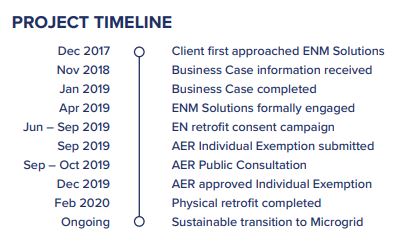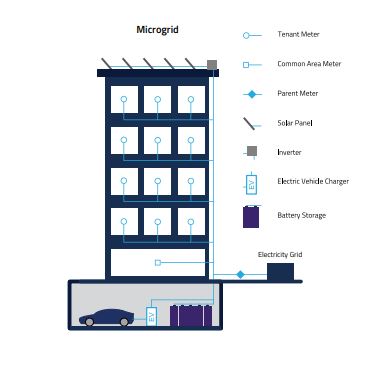Energy Strategy in Strata – Case Study
The Future of Energy in Strata
The energy landscape within strata title communities is often overlooked, difficult to navigate, and expensive. The conversation to define your Energy Strategy is more important now, than ever before.
What is Energy Strategy in Strata?
Energy Strategy for strata title communities (Strata) is the collaborative process of planning, executing, adapting, and managing energy infrastructure, investment, and compliance requirements for the future.
Collaboration
It is no secret that Strata can be slow and reactive when it comes to making decisions. With the multitude and variability of stakeholders, this is understandable; however, not reason enough to fail in meeting your Energy Strategy obligations.
The process of collaboration captures the broader economic, social, technological, environmental and compliance related issues and opportunities early and ensures all relevant stakeholders are involved and informed. The engagement of all relevant stakeholders ensures that with regular communication and review, planning can be adapted swiftly and effectively.
Consider forming a subcommittee that can work through your Energy Strategy.
Planning
The first step in the planning process is to evaluate and define the current ’state of play’. This establishes the starting point from which to build your Energy Strategy, and asks questions surrounding how your Strata will report and evaluate performance and consideration on whether a private electricity network (Embedded Network / Microgrid) is required.
Embedded Networks
An Embedded Network is a cornerstone of energy management in Strata. It is a privately owned and operated electricity network at a site that has multiple customers and are frequently found in strata title communities. Many readers may have had negative experiences with these networks; however, when the Strata is in control there are a plethora of benefits. These include, greater visibility of consumption, utilising common areas for the benefit of all occupiers (by installing Solar Generation, Battery Storage and EV Charging), and a clear transition to a Microgrid.
For more information on Embedded Networks, visit ENMSolutions.com.au.
Defining what you want to achieve by evaluating ‘non-essential’ upgrades, such as solar generation, battery storage, lighting and electric vehicle (EV) charging; and, ‘essential’ upgrades, including switchboard and wiring (for safety and amperage requirements), roofing membrane (for installing solar generation), and Heating, Ventilation, and Air-Conditioning (HVAC).
The next step is when the challenge really takes shape, addressing the ‘how’ rather than just the ‘what’. Working backwards from what you want to achieve, by defining goals and setting stage gates, will help set your budget and allocate responsibilities.
Failing to plan can lead to unexpected costs, safety and compliance issues, lost value, and profit that could have been invested.
Executing and Adapting
Having taken the time to ask the necessary questions you can comfortably and confidently begin to execute your Energy Strategy. Working with specialist partners ensures your vision is executed within a defined scope, keeping sight of the goals set by the Strata.
As technology progresses, regulations change and opportunities continue to be realised; adapting, and refining the Energy Strategy, to remain current and optimised, is crucial.
Although a plan has been agreed, it must be made clear from the start that the plan could change, and you may need to adapt your strategy.
Managing
Owners, committee members, and other stakeholders can be transient and lose interest over time. Who will be managing the progress over the following weeks, months, and years? Are they an independent and qualified party, without a conflict of interest? The responsibility to keep stakeholders informed and stay up to date with the changing rules, regulations and technologies is an important one.
ENM Solutions is an independent expert and leading provider of energy and Professional Services in Embedded Networks and Microgrids. Our expertise in defining your Energy Strategy ensures your Strata is not only prepared to address these challenges, but to optimise the value and opportunities they present.
Case study – Energy Strategy in action
In 2018, ENM Solutions was approached to conduct a business case and feasibility study to determine the suitability of an Embedded Network with solar generation for an apartment building in Queensland.
Built in the 1960’s, the building required significant upgrades to the wiring and electrical switchboards to improve power quality/amperage, and to comply with safety and compliance requirements. This triggered the replacement of electricity meters which provided the added benefit of clear visibility of consumption for both the consumers and owners corporation.
ENM Solutions was engaged to procure electricity metering and project manage the brownfield retrofit of an Embedded Network which required approval from the Australian Energy Regulator (AER) through an Individual Exemption. Achieving the exemption required a thorough and rigorous process to obtain “Informed Consent” from all Occupiers at the site.

We received consent, submitted the application, and gained approval in less than 12 months from commencement.
With solar generation as the next step for the site, the ability to store energy in an onsite battery and how EV Charging will be incorporated is being discussed.
This is an example of how a collaborative, well planned, adaptable Energy Strategy, including an Embedded Network, can provide a path to the future of energy in Strata.
Should you or a project you are involved with be interested in discussing Energy Strategy, including consideration of an Embedded Network or Microgrid, please contact us for an informed discussion about your Energy Strategy.
This case study was contributed by Angus Gauld, ENM Consultant, ENM Solutions.



Leave a Reply